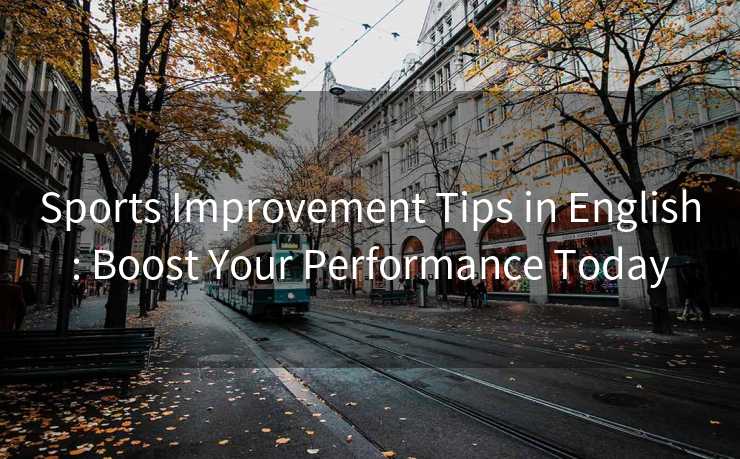Sports Improvement Tips in English: Boost Your Performance Today
Whether you’re an amateur athlete aiming to level up or a seasoned competitor seeking marginal gains, mastering sports performance requires a strategic approach. With global training resources often available in English—from scientific journals to elite coaching programs—understanding key improvement strategies in this language unlocks new opportunities. This guide breaks down actionable tips to enhance your athletic prowess, blending science-backed methods with practical advice.

1. Structured Training Plans for Maximum Efficiency
A well-designed training plan is the backbone of progress. Without structure, efforts can feel scattered, leading to plateaus or injuries. Here’s how to build an effective regimen:
a. Setting Clear Goals
Define SMART goals (Specific, Measurable, Achievable, Relevant, Time-bound). For example, instead of “get faster,” aim for “reduce my 5K time by 30 seconds in 8 weeks.” Writing goals in English helps clarify priorities and track progress. Use apps like Strava or Garmin to log workouts and visualize improvements.
b. Periodization Techniques
Periodization divides training into phases (e.g., base building, strength, peaking) to prevent overtraining and maximize adaptation. A classic model includes:
- Macrocycle: Year-long plan (e.g., preparing for a marathon).
- Mesocycle: 4–6 week blocks focusing on specific skills (e.g., endurance or power).
- Microcycle: Weekly schedules with varying intensity.
For instance, a soccer player might spend 4 weeks on aerobic conditioning, followed by 4 weeks of speed and agility drills.

c. Cross-Training Benefits
Cross-training reduces injury risk and improves overall fitness. Activities like swimming (low-impact cardio), yoga (flexibility), or weightlifting (strength) complement sport-specific training. English-language resources like Runner’s World or Strength & Conditioning Journal offer tailored cross-training routines.
2. Nutrition and Hydration Strategies
Fueling your body correctly is non-negotiable for peak performance. Small dietary tweaks can yield significant results.
a. Pre-Workout Fueling
Eat a meal 2–3 hours before exercise containing carbs (for energy) and protein (for muscle preservation). Examples: oatmeal with berries and Greek yogurt, or a banana with almond butter. Avoid heavy, greasy foods that may cause discomfort.
b. Post-Workout Recovery
Within 30 minutes of training, consume a 3:1 ratio of carbs to protein to replenish glycogen and repair muscles. Options include a chocolate milk shake, grilled chicken with quinoa, or a whey protein smoothie. Research from the International Journal of Sport Nutrition and Exercise Metabolism confirms this window optimizes recovery.
c. Hydration Guidelines
Dehydration impairs performance by up to 20%. Drink water consistently throughout the day, not just during workouts. For intense sessions (>60 minutes), add electrolytes (e.g., sodium, potassium) via sports drinks or natural sources like coconut water. Monitor urine color—pale yellow indicates proper hydration.
3. Mental Toughness and Focus Enhancement
Athletic success isn’t just physical; it’s mental. Cultivating resilience and concentration separates good athletes from great ones.
a. Visualization Techniques
Spend 10–15 minutes daily visualizing successful performances. Imagine every detail: the sound of the crowd, the feeling of your muscles working, and crossing the finish line. Studies show this activates neural pathways similar to actual practice, boosting confidence.
b. Stress Management
Chronic stress elevates cortisol, hindering recovery and focus. Practice mindfulness meditation, deep breathing, or journaling to reduce anxiety. Apps like Headspace offer guided sessions tailored to athletes.
c. Goal Setting Psychology
Break long-term goals into smaller milestones. Celebrate each achievement to maintain motivation. For example, if your goal is to deadlift 200kg, celebrate hitting 180kg first. This “small wins” approach keeps momentum.
4. Technical Skill Refinement
Mastering sport-specific techniques requires deliberate practice. Here’s how to refine your skills:
a. Video Analysis
Record your movements (e.g., a golf swing or tennis serve) and compare them to professionals. Slow-motion playback highlights flaws like poor form or timing. Free tools like Coach’s Eye allow frame-by-frame analysis.
b. Drills and Repetition
Isolate weak areas with targeted drills. A basketball player struggling with layups might practice footwork drills 100 times daily. Repetition builds muscle memory—aim for quality over quantity.
c. Feedback from Coaches
Seek constructive criticism from experienced coaches. They spot nuances you might miss, such as inefficient running form or incorrect grip. Many international coaches publish articles in English, offering insights into advanced techniques.
5. Rest and Recovery Essentials
Rest is when your body adapts and grows stronger. Neglecting recovery leads to burnout and injury.
a. Sleep Optimization
Prioritize 7–9 hours of quality sleep nightly. During deep sleep, growth hormone repairs tissues and consolidates memories. Create a bedtime routine (e.g., no screens 1 hour before bed) and keep your bedroom cool and dark.
b. Active Recovery Methods
On rest days, engage in low-intensity activities like walking, swimming, or foam rolling. These boost blood flow without stressing the body. Yoga or Pilates also improve flexibility and core strength.
c. Injury Prevention
Warm up thoroughly before workouts (dynamic stretches like leg swings) and cool down afterward (static stretches holding 20–30 seconds). Listen to your body—if something hurts, stop. Consult a physiotherapist for persistent issues.
Conclusion: Start Small, Sustain Progress
Improving in sports is a journey, not a sprint. Implement one tip at a time, track your progress, and stay consistent. Whether you’re refining your English-language training knowledge or pushing physical limits, these strategies will help you reach new heights. Remember: small, consistent actions compound into extraordinary results.
(Image: Athlete performing a structured workout with a coach—visualize your own path to success!)
新闻资讯
站点信息
- 文章总数:1
- 页面总数:1
- 分类总数:1
- 标签总数:0
- 评论总数:0
- 浏览总数:0

